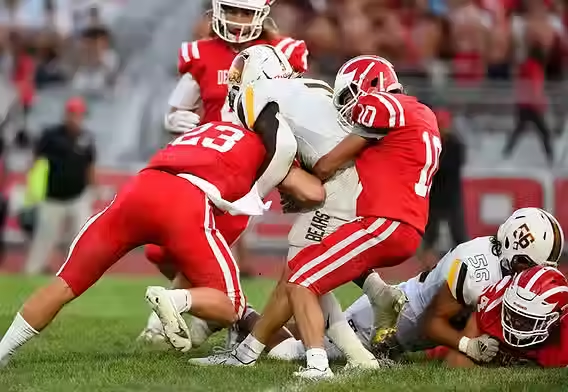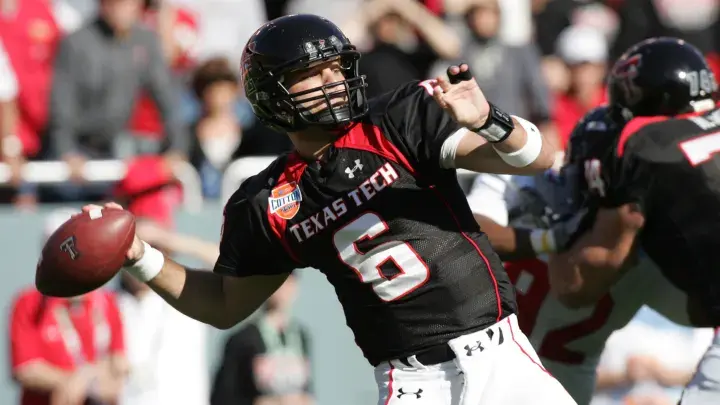Air Raid... On Defense?
- Jeremy McKinney

- Jun 18
- 7 min read
Prior to the 2024 season, I had spent over a decade coaching on the defensive side of the ball as a high school defensive coordinator. I became a head coach for the 2022 season, and I continued to call our defense. However, for the 2024 season, I was switching over to the offensive side of the
ball to call the plays for the first time since 2007.
I wanted to take the philosophy we had developed on defense and find a comparable offensive philosophy. My previous experience coaching offense was primarily in the wing-t. I had long admired Coach Mumme and Coach Leach, and I had a simplistic understanding of the Air Raid. I was intrigued by the Air Raid for its philosophy and its success. So I went down the rabbit hole and took the Air Raid Certified course and the Masters courses, read books, and researched online all in the effort of trying to learn as much as I could. (I have thoroughly enjoyed all of the courses and it is by far the best way to learn the Air Raid!) What genuinely surprised me was how much our defensive philosophy that we developed had in common with the Air Raid. We were looking to achieve the
same things using similar methods but on the opposite side of the ball!
The more I learned about the Air Raid, the more I realized it was the offensive ideal of what we had tried to do on defense: stress simplicity and execution of basics through repetition. There was no thinking. The goal was to out-execute rather than out-scheme. It all clicked! We use a simple scheme that is predicated on execution and repetition of the fundamentals and simple fronts and coverages.
Our practices are short with quick periods, drills were designed to eliminate the unnecessary and emphasize the basics, and we focus on us more than the other team. All of which is exactly what the Air Raid does!
In the following paragraphs, I will attempt to explain how that came to be for our defense, and I will provide some examples of how it looks and our success in implementing it. I thought I could share our story as an example of success to apply Air Raid principles to defense in case other coaches were curious if it was possible.
As a defensive coordinator, we had dabbled in a few different schemes over the years, but I had always wanted to simplify defense as much as possible. I love football to the point of obsession, but I would certainly not classify myself as a scheme junkie. I found it cumbersome that defensive schemes often set out to have answers by using many fronts, pressures, and coverages. I believed that it didn’t need to be complicated to win high school football games. I wanted to simplify defense to the point where we were able to simply line up to any formation, play fast, and fly to the ball. We do not want our players thinking. We want them to line up, react and go! To do this, I set out on a mission in 2018 to simplify our defense to do just that. I devoured books, attended clinics, listened to podcasts and watched videos and coaches speak.
Going into the 2018 season, we felt we had found some answers. We switched to an odd front that allowed us to best use our personnel and it was mirrored on each side of the ball. Our adjustments to formations were simple, so alignment was not a problem. However, we had 147 different ways to send pressures and had what amounted to about 7 coverages. It was simple to call and learn, but we rarely ran any pressures and played only 3 or so of the coverages. We won a league championship with a very young team, and we won the first playoff game in school history. However, I still felt we could simplify more. We had spent a lot of time installing pressures and coverages that we were not running in games.
As we moved into 2019, I continued the quest to simplify. We were going to cut as much jargon out as we could to simplify the language, we were going to simplify run fits, and we were only going to install what we would run in a game. It seems like an obvious decision, but many fail to actually commit and follow through with doing that! We once again won our league championship, qualifying
for the playoffs, and we won two playoff games to finish as regional runner-up. It was the most successful season in school history!
We also eliminated all live tackling in practices. We either tagged hips or would “thud” the ball carrier. In practice, we are tagging hips 95% of the time. We can teach pursuit, tracking, and tackling extremely well without banging on each other in practice. Not only does it significantly reduce injuries, it saves time and forces your coaches to drill the proper techniques of those skills. (While not the
focus of this article, check out Buddy Teevens and “The Dartmouth Way” on YouTube for more information). The hard part of tackling is getting in proper position to make the tackle, not actually taking the ball carrier down. That can be drilled repeatedly in almost every defensive drill you do without live tackling. This caused us to get better at tackling by teaching, drilling, and executing technique, and it made our players hungry to hit by the time we got to Friday night!
Just like many programs, 2020 changed how we operated due to the regulations put in place just to have a season. We were forced to simplify even more due to practice and meeting limitations. We hammered fundamentals, run fits, and pursuit. We worried more on perfecting what we could do and control as opposed to what the opponent may do. We wanted to out-execute rather than out-scheme the other team. Each week, you were not even sure if you would even play because any team could get shut down at any point due to exposure.
Our scheme was the most simple yet. We no longer discussed “force” or “spill” players. We focused on tracking the hips of the ball carrier. Our defense was simplified to either being an inside or outside hip player. We did pursuit everyday in the preseason and started each week of practice with it. It became our identity. Our players loved it and looked forward to it. I had never been a part of a team where the players loved pursuit drills until this point!
However, we didn’t bother with setting up cones or other traditional ways of doing the drill. We simply tracked the hips of the ball and tagged off on the correct hip. We had a runner sweep out between the hash and the numbers, and we’d work to his hip. If we didn’t set the edge correctly with the outside hip player, or our pursuit angles were not what we needed, we’d blow the whistle, reload
and do it again. We got to the point where we could get 10+ good reps in 5 minutes. Quick and efficient while stressing the most important aspect of defensive football: getting players to the ball in position to tackle!
We could teach and drill the “fits” without bogging down our players with football jargon. We wanted it to be simple enough that youth players could understand it. Everyone on our team could tell us what hip they tracked based upon the position they played! There was no thinking! We simplified coverages too. We even began implementing traditional spot dropping! We were willing to bet that we were better at dropping than high school quarterbacks were at throwing consistently accurate passes.
Our game planning and practices turned into focusing on the top 3-5 runs and 3-5 passes of the opponents. Our group and team periods would be 10 minutes, and they would be focused on these few plays. We felt with our simplicity on defense, we wanted to spend our time focusing mostly on what the opponent was best at. We did not want to spend time mired in the minutiae. We would have specific situation based periods later in the week that would expose our defense to the wrinkles the opponents had shown, but we did not “major in the minors.”
Our school had not won a league championship since 1990, and had yet to win a playoff game in 5 previous attempts. In 2018, with a very young team, we won a league championship and won the school’s first playoff game. In 2019, we won another league title, two playoff games and finished as regional runner-up. Then from 2020-2023, we probably ran the most simple defense in Ohio.
In 2020, our starting defense gave up 3.3 points per game on our way to another league title and a Final Four berth. In 2021, our starting defense gave up only 2.7 points per game and did not surrender a touchdown in 10 consecutive games on our way to another league title, Final Four and a 14-1 season. In 2022, we had a 14 game winning streak, won a league title and finished 14-2 as the Ohio State Runners-Up in Division III. In 2023, we finished 10-3 and won our 6th consecutive league championship. This past season, 2024, we finished 9-3, won our 7th consecutive league championship while running the Air Raid on offense and set the school record for average points per game with 38.6 ppg.
We have been extremely fortunate to have had some very good teams and very talented players, but I certainly believe the changes we have discussed have helped with that success! We were able to maximize the talent we had by letting them play fast without thinking. They knew what to do and how to do it aided by our simplicity and dedication to quality repetitions of fundamentals and plays instead of focusing on complicated schemes, schemes of the week, or things that are outside of our control. The philosophy behind the Air Raid offense can be applied to the game of football in any of the three phases of the game, and it has been a tremendous asset to our program!
Jeremy McKinney
Head Football Coach
Bloom-Carroll HS







Comments